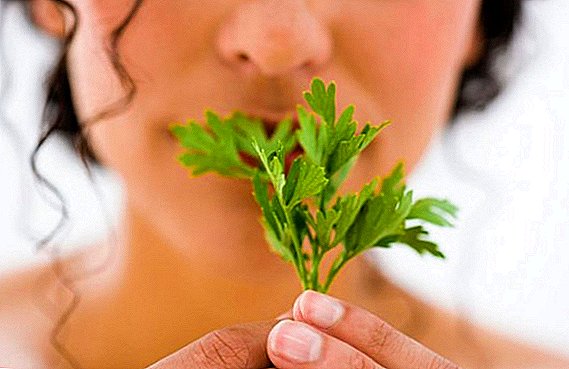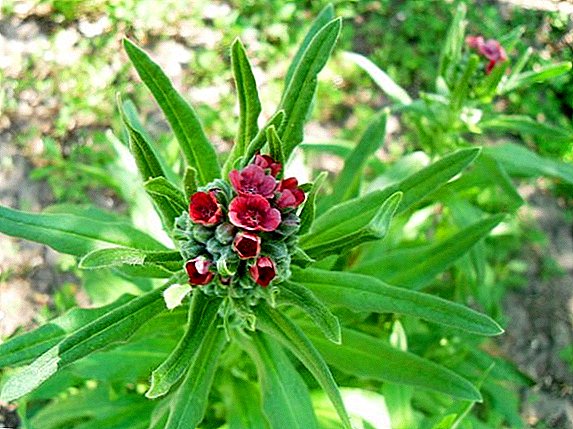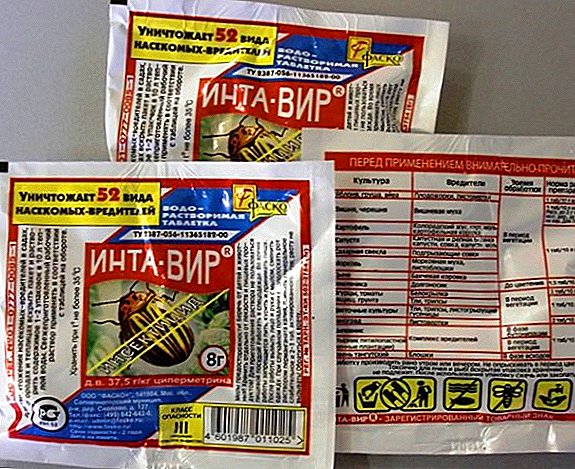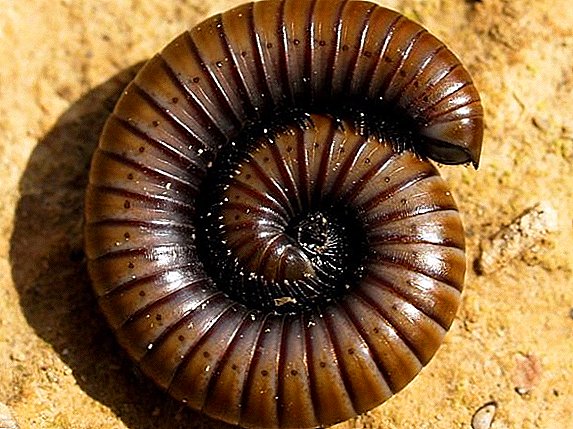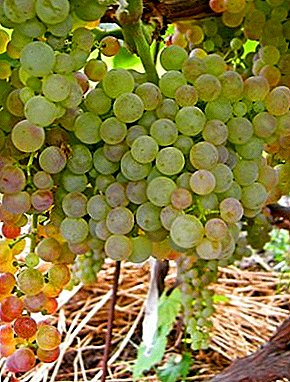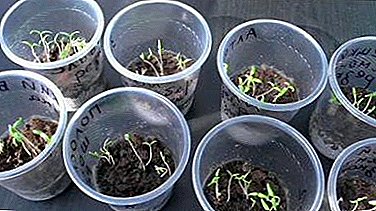
One of the important stages of growing seedlings of tomatoes is the stage of sowing seeds and their germination.
This period is one of the most exciting: the mystery of the birth of a new plant is hidden from the eyes of the gardener, constantly experiencing, and will everything work out?
This article is about the timing of the emergence of the first seedlings of tomatoes and how to speed up these terms. Also from the article we find out how long you need to worry if there is no germination.
What determines the time of germination of seeds?
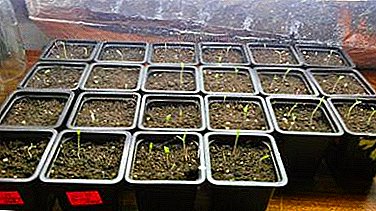 From production time: Seeds harvested last summer, under all conditions, will grow in 4 days, and those that were collected 3 years ago, under the same conditions, in 7–10 days.
From production time: Seeds harvested last summer, under all conditions, will grow in 4 days, and those that were collected 3 years ago, under the same conditions, in 7–10 days.- From variety: unpretentious, ordinary varieties sprout much faster than, for example, hybrid varieties that are quite capricious.
- From pretreatment: dry seeds thrown into the ground will begin to peck up only in 10 days, but previously soaked in warm water and treated with special solutions in 4 to 5 days.
- From temperature: The ideal temperature for the emergence of shoots is + 23C - + 25C. At this temperature, seedlings usually appear on the 5th - 7th day. But if the temperature in the room where the containers are located is much lower, then they will have to wait much longer.
- From the depth of the bookmark: Naturally, the seeds, lightly sprinkled with soil, will stick to the surface much faster than those that are covered with a thick layer of substrate.
- From the ground: fragile shoots are much harder to break through hard, compacted soil. It is advisable to add to the substrate the components that make the soil friability and lightness: peat, sand, sphagnum moss, humus, vermiculite, etc.
- From the light: any shoots always reach for the sun. If the seeds do not have enough light, they will “sit” in the soil for a long time, without giving signs of life. Therefore, often seeds are sown in transparent plastic containers and immediately put on a sunny place or under artificial lighting.
- From soil disinfection: in the soil can be fungi and bacteria, pathogens of infectious diseases. Seeds can in this case die at the stage of germination.
When to start the timing of the appearance of sprouts?
The timing of the emergence of seedlings should begin from the day when the seeds were sown, the container is tightened with film and moved to a warm place.
After how many days do tomato seedlings appear at home?
Tomato seeds by average indicators sprout in 6 - 10 days after sowing.
Pre-processed
 Initially, it should clarify the concept of "processed". Seeds of tomatoes can be sold in inlaid form: the manufacturer puts on them a thin nutrient mixture, which improves their properties, increases the germination rate and yield, increases resistance to diseases. The shoots of inlaid seeds appear earlier (on days 4–5) and turn out to be especially strong.
Initially, it should clarify the concept of "processed". Seeds of tomatoes can be sold in inlaid form: the manufacturer puts on them a thin nutrient mixture, which improves their properties, increases the germination rate and yield, increases resistance to diseases. The shoots of inlaid seeds appear earlier (on days 4–5) and turn out to be especially strong.
The term "pre-treatment" many gardeners mistakenly understand the heating and hardening of seeds (the impact on seed by high and low temperatures). Such procedures do not affect the speed of emergence, but prepare future plants for adverse weather conditions.
Procedures that affect the rate of germination of seeds include soaking seed for a certain time, immersing seeds in growth stimulants or germinating seeds. Seeds treated in this way will also begin to appear on the surface of the soil in 4-6 days.
If before sowing the seeds were treated with the preparation for further storage, the first shoots usually appear after 15 days.
Unprocessed
Pre-treated with different compositions and not germinated dry seeds that are sown directly in the ground, can germinate up to 10 days or more.
The minimum and maximum time before germination
Under favorable conditions (temperature, light, humidity), the pre-treated seeds, which were collected last year, will begin to hatch after 4 days. Respectively, dry seeds, collected 3 - 4 years ago, will seem at best in 2 weeks. And if you do not comply with the conditions necessary for growing seedlings, then the duration of germination may be further delayed.
How to affect the germination period?
Speed up
 Immersion in a solution of growth stimulants. Often, gardeners before sowing seeds are kept in a solution of growth stimulant (Appin, Zircon, Heteroauxin, etc.): the method of cultivation and the duration of the procedure - according to the instructions. You can use the popular way: immerse the seed in a solution of aloe juice (1: 1) or honey water (1 tsp per cup of water) for 3 - 4 hours.
Immersion in a solution of growth stimulants. Often, gardeners before sowing seeds are kept in a solution of growth stimulant (Appin, Zircon, Heteroauxin, etc.): the method of cultivation and the duration of the procedure - according to the instructions. You can use the popular way: immerse the seed in a solution of aloe juice (1: 1) or honey water (1 tsp per cup of water) for 3 - 4 hours.- Seed soaking. Seed material is placed in a cotton bag and immersed in warm water (+20 - + 25С) for 12-18 hours. During the steeping, the seeds must be constantly mixed, and the water must be changed. After a similar procedure, the seeds can be further sent for germination, and you can - directly into the ground.
- Sprouting seeds. For germination, you must prepare a saucer, cloth, gauze or paper towel. Moisten the fabric, place it flat on a saucer, pour on it and distribute the seeds of a single-grade tomato over the surface, cover the container with a plastic lid or plastic bag and place in a warm place for 3 to 5 days.
- Strict compliance with sowing requirements. For rapid germination, it is necessary to keep the air temperature + 23С- + 25С and a high level of humidity (covering the container with plastic wrap or glass), then the shoots can break through for 5 or even 4 days after planting.
Slow down
If the seedlings began to grow rapidly and excessively stretched, then this process should be slowed down. To do this, it will be enough to lower the temperature in the room where the boxes with the seedlings are located, to + 18C - + 20C; reduce watering (only as the upper layer of the substrate dries out); apply special tools that slow down the growth of the aerial parts of the plant and stimulate root growth (for example, "Athlete").
When to start worrying?
If the seeds did not even begin to spit after 12 to 17 days, the gardener should be worried. It would be advisable to “dig up” a small area in order to see firsthand the degree of development of sprouts. In the absence of any signs of germination, the seeds need to be sown. Of course, it is first necessary to analyze the situation and answer the question: "Why did the seeds not germinate?"
If you comply with all the necessary requirements for the process of preparing seeds and their sowing, set out in the article, then you should not worry about the emergence of seedlings.


 From production time: Seeds harvested last summer, under all conditions, will grow in 4 days, and those that were collected 3 years ago, under the same conditions, in 7–10 days.
From production time: Seeds harvested last summer, under all conditions, will grow in 4 days, and those that were collected 3 years ago, under the same conditions, in 7–10 days. Immersion in a solution of growth stimulants. Often, gardeners before sowing seeds are kept in a solution of growth stimulant (Appin, Zircon, Heteroauxin, etc.): the method of cultivation and the duration of the procedure - according to the instructions. You can use the popular way: immerse the seed in a solution of aloe juice (1: 1) or honey water (1 tsp per cup of water) for 3 - 4 hours.
Immersion in a solution of growth stimulants. Often, gardeners before sowing seeds are kept in a solution of growth stimulant (Appin, Zircon, Heteroauxin, etc.): the method of cultivation and the duration of the procedure - according to the instructions. You can use the popular way: immerse the seed in a solution of aloe juice (1: 1) or honey water (1 tsp per cup of water) for 3 - 4 hours.